Medical Practitioners
With us there was a Doctour of Phisyk
In al this world ne was there noon him lyk
To speke of phisik and of surgerye...
Wel knew he the olde Esculapius (Aesculapius)
And Deyscorides (Diascorides) and eek Rufus (Rufus of Ephesus)
Olde Ypocras (Hippocrates), Haly (Ali ben-Abbas) and Galeyn (Galen),
Serapion (Serapion of Alexandria [1st c CE] or Serapion the Younger [12th c],
Razi (Rhazes) and Avycen (Avicenna)...
--from the Prologue to The Canterbury Tales (c. 1390)
by Geoffrey Chaucer

Galen, Avicenna, and Hippocrates: The Three Authorities on Medical Theory and Practice
_________________
The good physician should:
- have natural ability
- be industrious and thoughtful
- be well taught
- willing to consult another's opinion
- speak plainly
- not harsh, forward or excessively cheerful
- keep confidences
- be healthy, clean and well-dressed
- use suitable perfumes
- mindful of how he sits, carries himself
- be serious and kind to all
- unconcerned about fees
- willing to render needed assistance to strangers
- maintain and guard the art of healing
- the honorific "doctor" comes from the Latin word docere (to teach), thus, in addition to his practice, every physician has an obligation to teach the art of healing and hand it on
![]()
Handing-on the Art of Healing
Europe
Europeans had limited access to the works of Hippocrates and Galen before 1000 CE. Healing was less an art than a practiced craft.
Illness itself aroused ambivalent feelings. If a disease was the result of divine action (possibly to test or punish the victim), it might be sinful to interfere with its course except through prayer, repentence and hope for a miracle. On the other hand, those who ministered to the needs of the sick were considered agents of charity. Many were members of the clergy. Surely it was good to do whatever was necessary to restore the well-being of the temple of the soul.
Still, it was best to avoid getting sick in the first place! One's chances for preserving and maintaining good health could be improved by keeping the body's four humors in balance through routine bleeding or cupping:
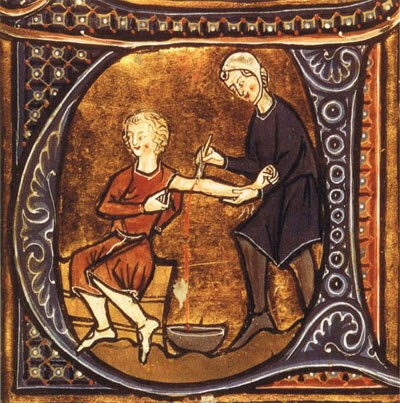
A patient is bled to insure humors are kept in balance.
Another way to prevent illness was to keep the body free of harmful toxins:
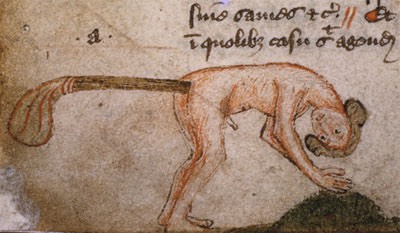
A clyster (enema) was often used to purge a patient of the toxins in bodily waste.
Monastery schools (~5th c)
Goals:
- standardizing and preserving Christian dogma
- scriptoria(copying and storing sacred and selected secular manuscripts)
- preserving and practicing Christian lifestyle
- herbaria(maintaining herb and vegetable gardens; orchards)
- vivaria(husbanding domesticated animals)
- valetudinaria(providing hospice care for residents and wayfarers)
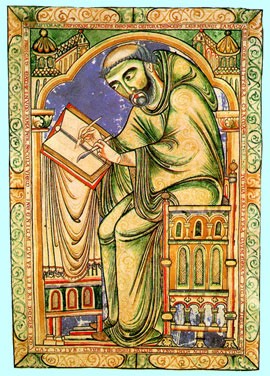
- The infirmarius was the monk in charge of maintaining the health of his fellows through regular bleeding and purging. His practice was guided by astrology and numerology as much as Hippocrates' Prognostics.
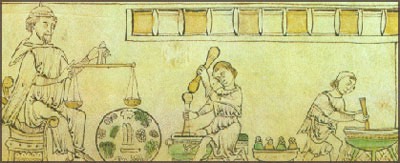
Monks prepare herbal medicines.
Cathedral schools (8th c)
- founded by Charlemagne (742-814)
- most notable:
- Paris
- Chartres
- served similar purpose to monastery schools
- prepared professionals in law and medicine as well as theology
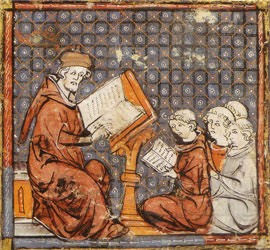
Universities (12th c)
- product of guild system
- Paris: guild of masters
- Bologna: guild of students
- four faculties: Arts, Theology, Law, Medicine
- seven liberal arts
trivium(language arts) grammar rhetoric logic
quadrivium(mathematical arts) arithmetic geometry music astronomy
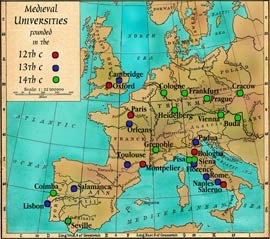
Although its origins are hazy, the first formal European medical school was founded in Salerno, Italy around the 9-10th century CE. Its early teachers included Greeks, Romans, Jews and Muslims. Women were admitted as pupils. The curriculum included anatomy, dissection, practical medicine and professional behavior.
____________________
Medical school at Jundishapur (~ 6th c)
Thanks to the the survival of Greek learning in the Middle East, institutions for formal medical education were organized there far earlier than in the West. An academy modeled on the famed Museum in Alexandria was established in Jundishapur in 560 CE by the enlightened Persian leader, Khosru I. As a major repository for ancient Greek texts, Jundishapur attracted many teachers and students interested in the practice of medicine. Teachers provided their pupils with certificates to show they had studied and mastered the medical arts. After Arabs conquered Persia in 638, Jundishapur became a center for translating Greek, Syriac and Indian texts into Arabic and Persian. In 931, the Caliph of Baghdad introduced examinations for medical students to demonstrate their skill and proficiency.

Spread of Islam from the time of the death of Mohammed (632) to 750
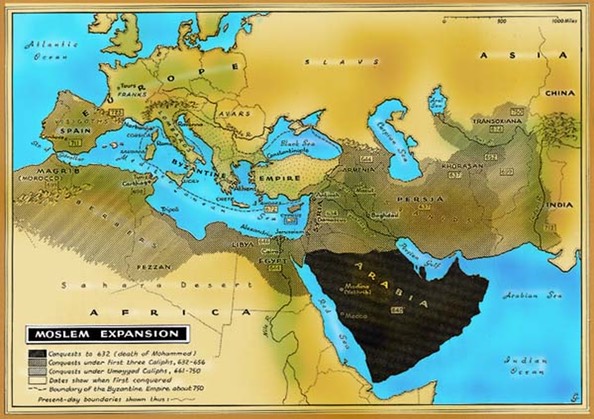
Islamic Contributors to Science & Medicine:
Rhazes
(Abu Bakr Muhammad ibn Zakariyya al-Razi)
c. 850-925
Baghdad
alchemist and medical practitioner
- wrote many medical texts including Al-Kitab al-Hawi (Liber continens), a 25-book compendium of Greek, Syriac, and early Arabic medical knowledge
- first to distinguish smallpox from measles
Avicenna
(Abu Ali al-Husain ibn Abdallah ibn Sina)
980-1037
Bokhara
physician
- traveled among rulers of central Asia
- wrote on all sciences
- medical textbook, Al-Qanun fi't al-Tibb(Canon on Medicine) used until 1650 in European universities
Averroes
(Abu'l Walid Muhammad ibn Rushd al-Qurtubi)
1126-1198
Cordova
philosopher
- translated Aristotle
Europeans Encounter the Muslim World (11th c)
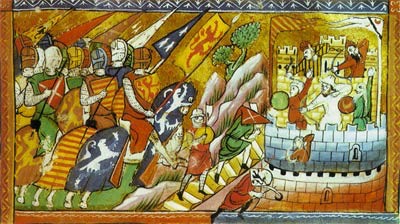
The Siege at Antioch
Major Translation Centers (12th-13th c)
- Southern Spain--Arabic to Latin
- Cordova
- Toledo
- Seville
- Southern Italy and Sicily--Arabic and some Greek to Latin
- Salerno
- Monte Cassino (monastery founded by St. Benedict in 529)
- Palermo
- Syracuse
Principal Sources of Ancient Medical Knowledge:
Author
Work
Latin translation by/from
When
Alhazen
Optics [including studies on the eye and vision]
?/Arabic
12th c
Avicenna
Al-Qanun fi al-Tibb
various translators/Arabic
12th c
Rhazes
Al-Kitab al-Hawi
various translators/Arabic
13th c
Averroës
commentaries on Aristotle
Michael Scot/Arabic
13th c
Hippocrates
various treatises
various translators/Greek & Arabic
12th-13th c
Aristotle
various treatises
various translators/Greek & Arabic
12th-13th c
Galen
various treatises
various translators/Greek & Arabic
12th-13th c
![]()
Training in Medical Theory
The fifty-year period between 1285-1335 was a transitional period in which medical practice in Europe took firm shape as a secular occupation. Church officials questioned whether a cleric could continue to serve as a priest after the death of a patient under his care. Regulations were introduced forbidding priests to practice surgery, although they were permitted to treat wounds, sores and fractures. For a time, monks were forbidden to leave their monasteries to study medicine, although this impractical rule was eventually softened.
Thanks to Avicenna, the works of Galen were finally being put into a form that could be fruitfully studied. Concordances and summaries appeared as teaching aids. Europeans began to view medicine as more of a science than an art or a craft. Best practice can be derived from first principles rather than trial and error:
- maintain and/or restore the balance of the patient's bodily humors
- preserve and/or restore the patient's constitution by manipulating diet, sleep, exercise, sex, climate
- observe the progress of a patient's illness carefully and take action (bleed, sweat, administer drugs, perform surgery...) to bring the patient to crisis as soon as possible
Those who read Galen's works carefully discovered occasional conflicts with Aristotle and other authorities. Teachers and students worked to reconcile these differences through academic disputation.
Melancholic
moody
glum
Sanguine
happy
healthy
The Four Humors 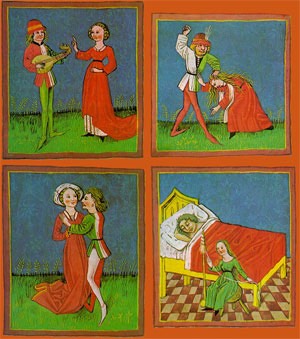
Choleric
irritable
hot-tempered
Phlegmatic
slow
droopy
![]()
Training in Medical Practice
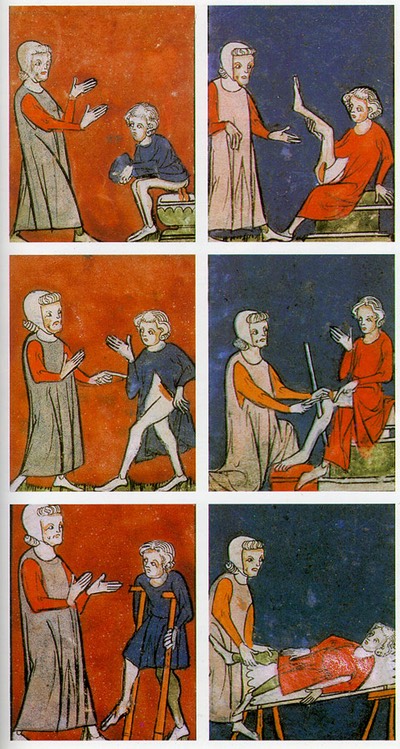
Illustrations from the Livre de Chirurgie (13th c.) show the physician treating patients who are suffering from a variety of complaints. Regardless of the horror presented by the injury (note the stake through the leg, center right) or the repulsiveness of the symptoms (diarrhea, top left), the neatly dressed physician is always calm and reassuring. The illustrations are unaccompanied by captions. They are intended to serve as a guide to the information elsewhere in the text and to be explained by someone knowledgeable.
The Medical School at Salerno
Salerno was a major center for translating ancient manuscripts from Arabic into Latin
- first formal medical school; founded ~ 9-10th c
- curriculum:
- anatomy (including dissection of the pig)
- practical medicine
- professional behavior
1140
- examinations introduced to certify qualifications
1200
- degrees of bachelor and master in medicine introduced
- master's program:
- study liberal arts
- study medicine
- complete a practical training period
1230
- works of Avicenna, Rhazes and others available
- medical licensing initiated
How we ought to be wary of what doctors do.
[Physicians] boast that they understand an illness when they don't.
They drag illnesses out so that they can get more money from the sick.
They prescribe syrups and electuaries and other things for the sick because they share in the profits that the apothecaries make on what they sell to their patients.
Every day we see that when the physician's cure goes wrong, he blames it on the patient, saying that he hasn't followed the right diet or didn't tell the truth about his illness. It is they who should be blamed for the mistakes they make, yet they blame the patient, who doesn't deserve it.
Physicians who first of all understand the illness, they ... can treat it: but every day we see physicians treating their patients haphazardly because they don't understand the illness.
--Ramon Llull (1272)
Medical Licensing
Sicily:
No one claiming the title of medicus is to practice unless he should come to the king with letters from the masters of Salerno testifying to his trustworthiness and sufficient knowledge....
Pope Gregory IX:
Too many rush quickly into practice and are incompetent. Ignorant of the rationale for treatment, they kill rather than cure. Under pain of excommunication, no one may practice medicine before being examined and approved by two masters selected from the Montpellier faculty by the bishop....
Salerno's requirements for independent practice:
- Pre-med--3 years of Logic
- Medicine--5 years including surgery
- Proof of study and having passed examination
- One year apprenticeship
By 1330s, it was widely agreed that a certain level of academic preparation guaranteed a physician's competence; healers lacking such training might be required to prove that they were equally well prepared.
![]()
Who practiced the healing arts?
Physicians
- attend to internal or systemic illness
- term "medicus" is sometimes used, but it is not quite synonymous with "physician" and is not as prestigious a title; equivalent to "healer" or "doctor"
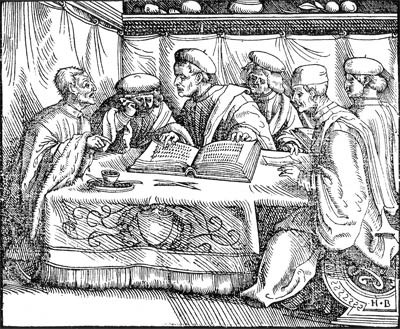
Physicians consult the textbook.
Surgeons
- treat external complaints (fractures, wounds, abscesses, skin ailments....)
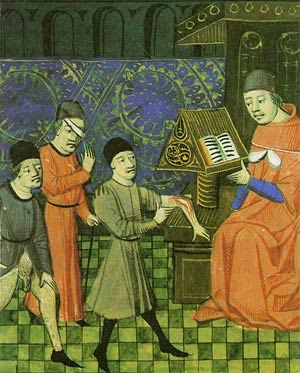
A surgeon sees patients in his clinic.
Apothecaries
- prepare medicines for physicians
- recommend remedies to the sick
- dispense drugs directly to the sick
- serve when no physician is available
- visit sick to read urines
[supplemented income as grocer, chandler, or other occupation based on selling products used in apothecary business]
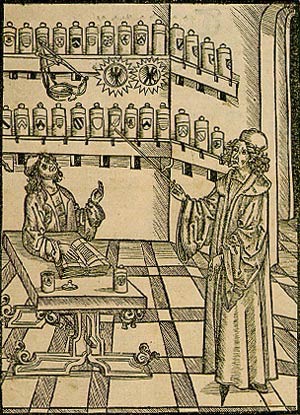
A physician selects a remedy at the apothecary's shop.
Barbers
- provide routine preventive medical care -- bloodletting, purging...
- shave and cut hair
- pull teeth
[supplemented income with mule-trading, iron-selling, cloth dyeing, offering surgical treatments for which they were nominally unqualified]
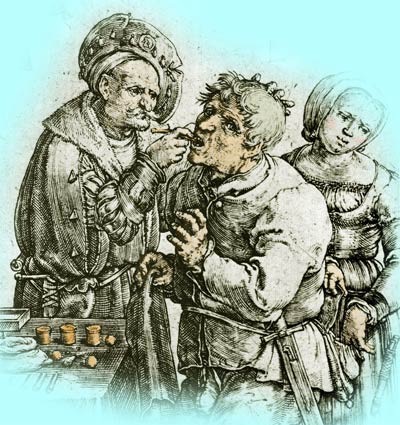
The barber pulls a tooth with the aid of his lovely assistant.
How were the healing arts practiced?
1. Consult one of a new genre of literature -- the health care guide:
- Practicae
- encyclopedic reference works relating to disease and treatment classified by organ and ordered from head to foot
- Consilia
- detailed descriptions of a single case with prescriptions for therapy
- Regimen
- short treatises with specific recommendations for food, drink, exercise and other health practices
- Experimenta
- proved remedies and recipes for medicines
- Treatises devoted to a particular type of therapy or disease
2. Deduce a diagnosis
- analyze humoral imbalance through examination of urine
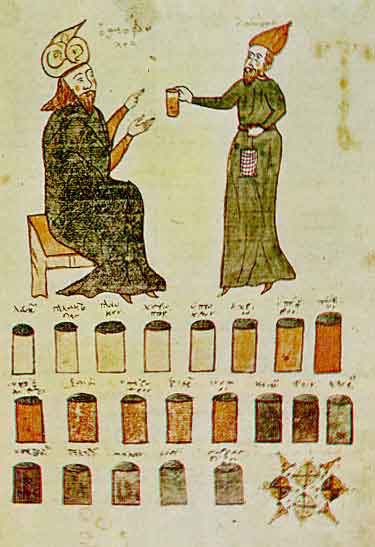
Guide for analyzing urine.
3. Provide patient with a prognosis
- observe course of symptoms
- follow doctrine of critical days
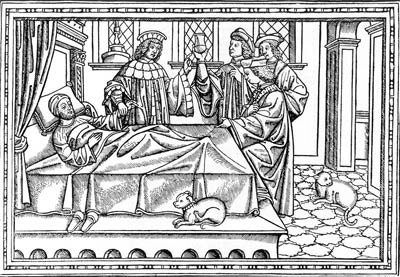
Physicians consider the diagnosis and contemplate a prognosis.
4. Prescribe therapeutic procedures
- manipulate patient's:
- diet
- lifestyle
- environment
- prescribe remedies:
- herbs
- minerals
- chemicals
- alter patient's physiology through:
- surgery
- bloodletting
- cupping
Where were the healing arts practiced?
Home
- primary place where sick were treated
- principal healers and caretakers were women of the household
- some health providers made housecalls (midwives, some physicians and surgeons)
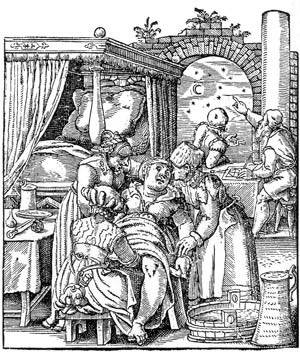
Midwives deliver a baby while astrologers cast its horoscope.
Apothecary shop
- treatment of ambulatory patients
Urban hospitals
- charitable institutions for treatment, not long-term care
Lazarettos and pest-houses
- waystations for terminally ill
- amenable to public regulation: quarantine
Valetudinaria
- medical centers in monasteries
- for routine care of resident monks and restorative care of passing wayfarers
![]()